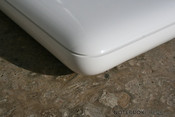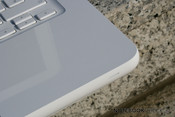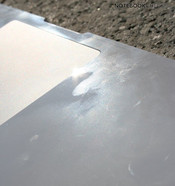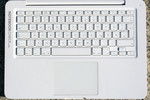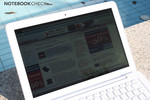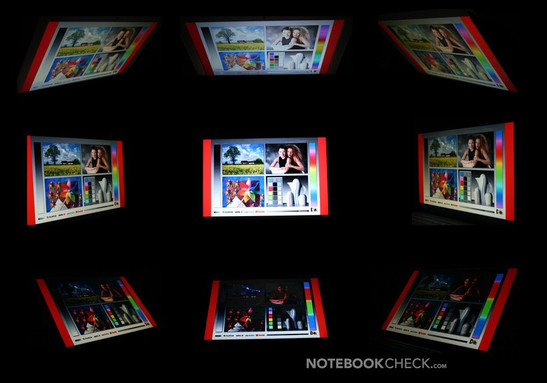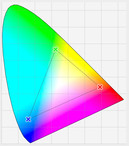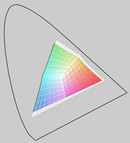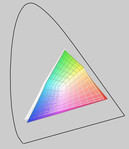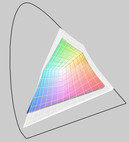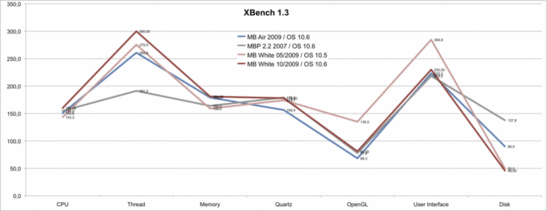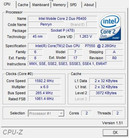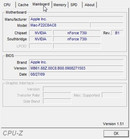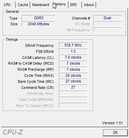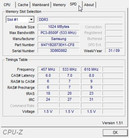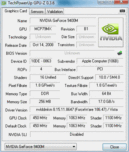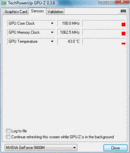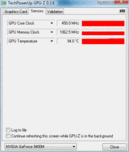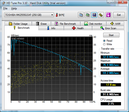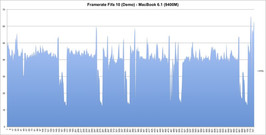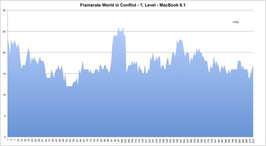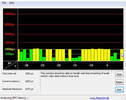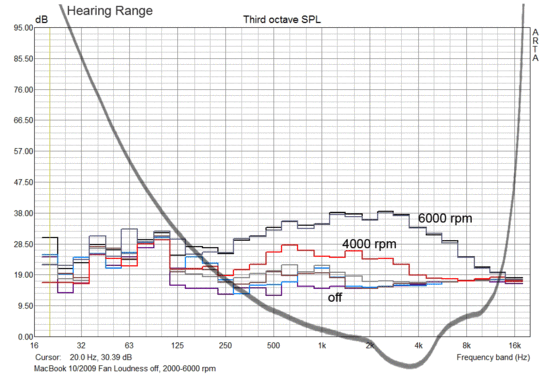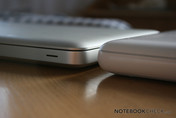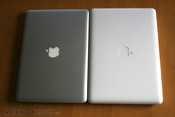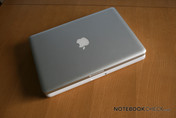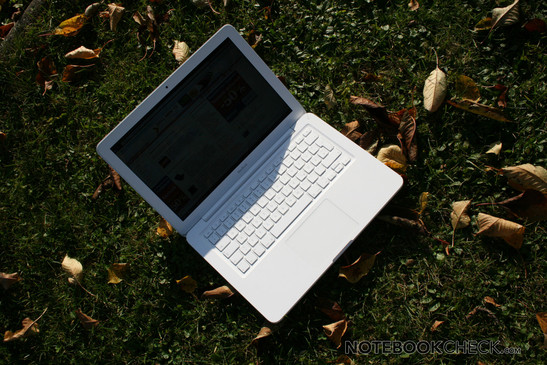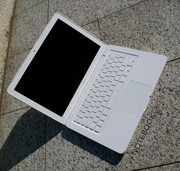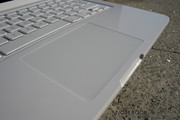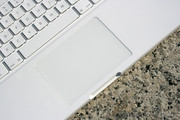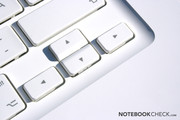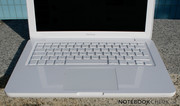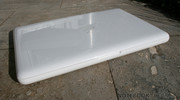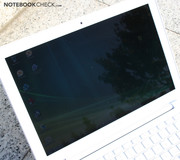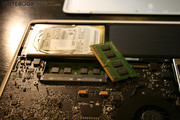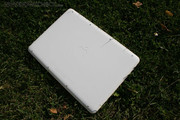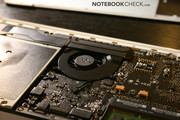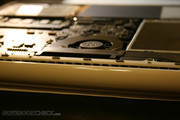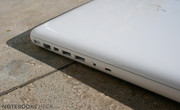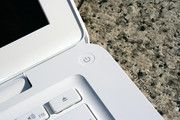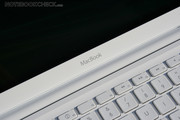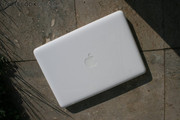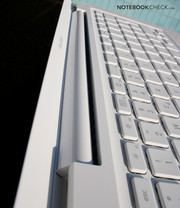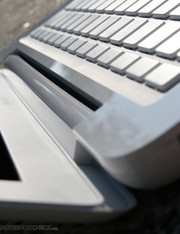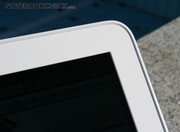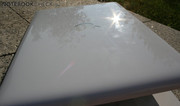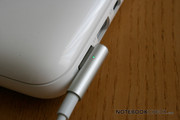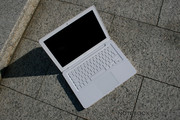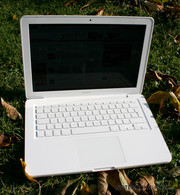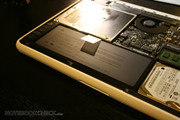Review Apple MacBook 6.1 Unibody 10-2009 Notebook
Case
Apple counts on a completely white design with many glossy surfaces in the new MacBook model. Unfortunately these are very sensitive to scratches and finger prints. The shape is brought more in line with the Unibody MacBook models and pleases by its simple grace.
Although polycarbonate (high-quality plastics) is used instead of aluminium, the stability of the case is very good. Only the area of the slot-in drive slightly yields under pressure. But, we could not provoke creaking or deflections.
The rubberized bottom side of the MacBook is interesting. Its inner part is reinforced by an aluminium sheet and it also replaces the feet. As this Apple notebook aspirates and blows off the air at the rear a distance to the desk top is not absolutely necessary.
The new plastic MacBook weighs a little bit more than the Unibody Macbook Pro 13". The 2.1 kg are still very portable and common for a 13" multimedia laptop (e.g., the Dell Studio XPS 13 weighs about 2.2 kg).
Equipment
Typical for Apple, the wired connectivity of the new white plastics MacBook is rather poor. Compared to the predecessor, Apple even scratched the FireWire port. Again it only provides two USB-2.0 ports, which could be quickly too less for the user. The built-in mini-display port drives external digital screens at high resolutions, but, all displays, besides the new ones from Apple, need an adapter for a charge.
The single audio port is not absolutely ideal too. It supports optical or analogue input or output with standard phone jacks. On the contrary, it works as input and output with the Apple headset. Furthermore, there are the common Kensington security slot and the ingenious MagSafe power socket. The new MacBook finally uses the same plug than the MacBook Air, whose cable leads straight towards the back.
As usual the 'Unibody' MacBook offers the following wireless communication features: (draft-)n from Atheros and Bluetooth 2.0+EDR. But, the infra-red receiver, which was built-in until now, was omitted in the new model.
The Atheros WLAN adapter proved to be reliable in our test against a Trendnet TEW-633GR and achieved a transfer rate of 3.6 MB/s during copying data in Windows at a distance of 3m and separated from the router by an exterior brick wall.
The software equipment of the new Unibody MacBook is typical for Macintosh computers. It comes with the newest Mac OS X operating system (in this case 10.6.1 Snow Leopard) and the software suite iLife 09 (iMovie, iPhoto, GarageBand, iWeb, and iVDVD) for common tasks. In addition it is as usually possible to install Windows via Boot Camp assistant. But, you'll need a Windows license.
Input Devices
Keyboard
Compared to the old white MacBook the single-key keyboard was not change at all. Despite a slightly firmer feedback than in our MacBook Pro test devices, it is also ready for long typing sessions. In the beginning the thin enter key and the layout optimized for Mac OS X are a bit odd. The key labeling is meager (e.g. labels for [ ] { } are missing) and you'll also have to do it without the appealing background light of the MacBook Pro models.
Touchpad
The white unibody MacBook now also got the glass pad of the MacBook Pro models as touchpad (called trackpad by Apple). So, you can enjoy the currently best gliding traits and surface structure in the market. Because it does it without dedicated button, the size is also more than sufficient and it's easy to work with its multi-touch gestures. Under Mac OS X it is possible to use up to 4 fingers at the same time to trigger different actions. As in all MacBooks this works excellent.
The Windows support of the touchpad was raised to a serviceable level by the current Boot camp drivers. Unfortunately, most of the multi-touch gestures are still not supported and the error detection is also not as sophisticated as under Mac OS X.
Display
The glossy 13.3" screen of the entry-level MacBook model still uses a resolution of 1280x800 pixel. What's new is that it uses a LED background light. This saves energy and should ensure an even illumination during the whole lifetime. The brightness too profits from the new background light. A maximum of 360 cd/m² (beside the center) should be sufficiently bright to outshine most reflections in rooms. However, because of the glossy surface, outdoor usage is a problem. As the glass plate in front of the display, known from MacBook Pro models, was not used in the smaller MacBook, it subjectively reflects less.
| |||||||||||||||||||||||||
Brightness Distribution: 80 %
Center on Battery: 325 cd/m²
Contrast: 756:1 (Black: 0.43 cd/m²)
The possible color space of the built-in screen (LP133WX2-TLC7) is clearly worse than of the current MacBook Pro series and can only be called 'average'. With factory settings the calibration is very bluish and optimized for best viewing angle stability.
Performance
Under Mac OS X we have already used the somewhat aged XBench 1.3. Since the release upgrade to Snow Leopard unfortunately not all results are comparably any longer. Especially the OpenGL and the User Interface results clearly declined (10.5 versus 10.6).
In comparison we checked the new Unibody MacBook against the old MacBook White (unfortunately still under Mac OS X 10.5), the current MacBook Air, and the old MacBook Pro with 2.2 GHz Core 2 Duo. Regarding CPU performance the new MacBook just got ahead of the old MBP. In the threading test this gets much more apparent. In the memory test, the DDR3 models win by a clear margin (new MacBook and MB Air). All in all, because it uses DDR3 RAM, the new MacBook can leave its predecessor slightly behind and reaches the level of the former MacBook Pro of 2007.
In practice the performance of the built-in components prove to be sufficient for all common tasks under Mac OS X. Because of the mediocre performance of the 9400M video card, 3D games might be ailing a little bit (more information about this in the gaming section under Windows). At the time of writing the CPU performance is, e.g., also sufficient for HD Videos from Youtube, which cannot utilize GPU performance. In our test both cores were used at 80% of their capacity and the video ran judder-free.
| PCMark 05 Standard | 4946 points | |
| PCMark Vantage Result | 3248 points | |
Help | ||
We checked the application performance of the built-in components under Windows Vista Business 32 Bit (installed via Bootcamp). As expected the PC Mark values (Vantage and 05) lie, due to P7550 and DDR RAM, in the upper middle class.
| 3DMark 05 Standard | 3871 points | |
| 3DMark 06 1280x800 Score | 2148 points | |
Help | ||
Considering the GeForce 9400M G is an on-board graphic solution, its gaming performance is very good. Compared to the predecessor models the graphics performance even improved as the new Unibody MacBook now also uses DDR3 RAM for main memory (which is shared with the GPU). Therefore, the performance does not longer differ from the Pro models (without dedicated GPU).
In our gaming test under Windows the 9400M proves to be capable for undemanding games. The new Fifa 10 could, e.g., be smoothly played at an average of 40 fps (minimum 12 fps, maximum 67 fps) in the native resolution of 1280x800 and with high details (all options on or high). At minimum details and 800x600 resolution the frame rate raises to 106.7 fps (minimum 70, maximum 166 fps).
However, older demanding games, e.g., the old World in Conflict, can just be played at medium details. In our test only 18 fps could be achieved at a resolution of 1280x800 pixel in the integrated benchmark. Because of the game design, at least the first player mission should be just playable with these settings.
The limits of the integrated entry-level graphics card and the moderate CPU quickly get apparent with demanding modern 3D games like, e.g., Armed Assault 2. Even after reducing all options to the minimum (3D resolution: 800x600, minimum details and visual range) only an unplayable framerate of 7 pictures per second was achieved in the single player mission "Trial by Fire".
Our article "Computer Games on Laptop graphic cards" lists which games should run (at which detail level) with 9400M video card in detail.
| Counter-Strike Source | |||
| Resolution | Settings | Value | |
| 1024x768 | high, 0xAA, 0xAF | 35 fps | |
The Toshiba MK2555GSXF hard drive in our test sample works at a velocity of 5400 revolutions per minute and achieves a maximum of 76 MB/s in the test. Faster 5400 rpm hard drives accomplish a maximum of 90 MB /s (Seagate ST9160310AS - 160GB in the Eee PC 1002HA). So, the performance is rather average. An SSD would clearly speed up the system. For example the HDD score in XBench 1.3 (see above) was clearly better in models with SSD (MacBook Air with integrated SSD and MBP 2.2 GHz with Patriot Memory Torqx).
The USB-transfer rate of 33MB/S, tested with a Corsair Survivor USB Stick, is within a normal range.
DPC Latencies
Much to our surprisse, the new MacBook is the first Apple Notebook which also achieves serviceable latencies under Windows (without deactivating the keyboard manager).
If you want to use an external sound card under Windows at least the latencies should not cause a problem.
Emissions
System noise
In our test the fan most of the time ran at 3000 rpm, whereas the maximum was 4500 rpm. The minimum noise level is the ambient noise when the notebook is switched off. This is only marginally exceeded by the minimum noise of the fan under normal load of 3000-3500 rpm. The top line is the measured maximum noise level. The fan only ran at 6000 rpm after we had changed the settings accordingly in the "smcfancontrol" tool (never during our tests).
Noise Level
| Idle |
| 30.2 / 30.2 / 30.2 dB(A) |
| Load |
| 30.5 / 36 dB(A) |
 | ||
30 dB silent 40 dB(A) audible 50 dB(A) loud |
||
min: | ||
Temperature
In the older MacBook Pro models Apple accepts high temperatures in the favor of low noise. This does not really apply to the MacBook White. While we could actually measure the high temperatures in our diagram after a 12 h stress test (Furmark + Prime 95) on a soft surface, the temperatures are very low under normal load (browsing the Internet, benchmarks, games, idle) or even after high load but on the desk. So generally the temperature was not an issue with the MacBook.
If you use the small Mac on your lap and the surfaces get inconveniently hot on the bottom side (the palm rests stay always sufficiently cool), you can manually increase the fan speed by the smcfancontrol (Freeware tool).
(-) The maximum temperature on the upper side is 46.9 °C / 116 F, compared to the average of 36.9 °C / 98 F, ranging from 21.1 to 71 °C for the class Multimedia.
(-) The bottom heats up to a maximum of 49.4 °C / 121 F, compared to the average of 39.1 °C / 102 F
(+) The palmrests and touchpad are reaching skin temperature as a maximum (32.8 °C / 91 F) and are therefore not hot.
(-) The average temperature of the palmrest area of similar devices was 28.8 °C / 83.8 F (-4 °C / -7.2 F).
Loudspeakers
The mono speaker in the MacBook is located in the right back area and sends its sound via display towards the user. The maximum volume suffices most fields of applications. However, it's not possible to use it as sound machine during a party. Because of the small diameter, the loudspeaker presents nearly no basses and so, the quality of the music replay is somewhat limited.
Battery Life
The Lithium-Polymer battery with a capacity of 60Wh is now no longer removeable and can not be replaced by the user. It is sufficient for a mobile use of up to 7h and 55 minutes in our test (reading of a text is emulated, min. brightness, WLAN off). During WLAN surfing a battery life of 5.5 hours was possible. In the worst case the notebook at least ran 1h 50 min on battery (Battery Eater Classic - full load - Windows Vista).
A sad thing about the battery is, that Apple saved on the integrated LED charge status indicator. It can only be found on the Pro models anymore.
During partly usage, the Li-Po battery was recharged within about two hours.
The small white notebook also convinces in terms of energy demand. If you compare it to the Dell Studio XPS 13, the values appear especially good. With 0.2 W and 0.5 /0.8 W (Windows) the switched off notebook even stays below the EU limit of 1W.
| Off / Standby | |
| Idle | |
| Load |
|
Verdict
The white Unibody MacBook is a well-done 13" notebook and offers a nice start into Apple's mobile notebook world. In particular the low system noise and the long battery life convince. In addition the good input devices, first and foremost the excellent glass touchpad are clear pros.
However, we did not like the meager connectivity and the glossy display that much.
Compared to similarly equipped Windows notebooks the price is competitive and adequate to the equipment.
Compared to the more expensive aluminium MacBook Pro 13 the keyboard light, a FireWire port, and the LED charge indicators are missing. In addition the display of the MacBook Pro features a bigger color space (wide gammut) and reflects more because of the glass plate in front of it. Naturally, the Unibody aluminium case is the biggest optical and haptical difference. It is a little bit slimmer and smaller and also weighs slightly less (2 kg). In return the poly-carbonate MacBook is clearly cheaper and comes with a bigger HDD at the time of writing.


 Deutsch
Deutsch English
English Español
Español Français
Français Italiano
Italiano Nederlands
Nederlands Polski
Polski Português
Português Русский
Русский Türkçe
Türkçe Svenska
Svenska Chinese
Chinese Magyar
Magyar
